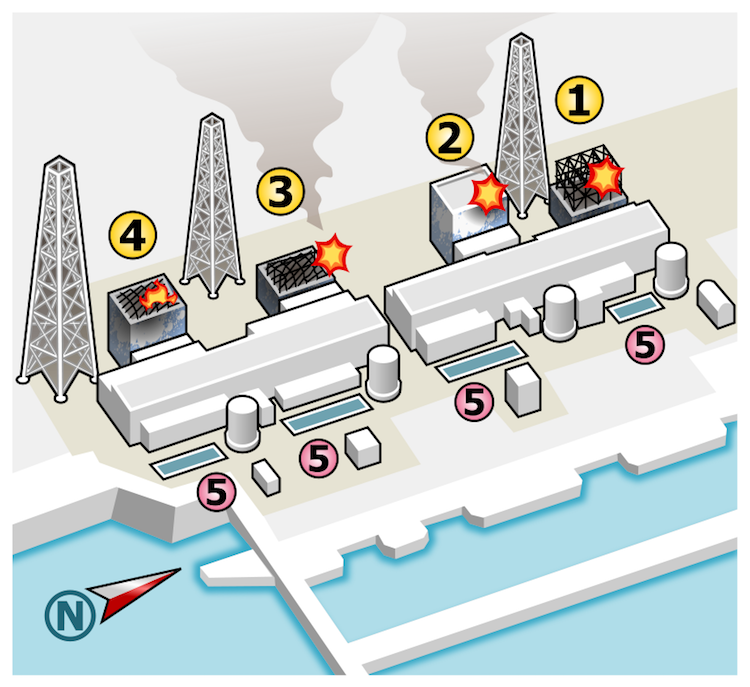Fukushima 2011 Basic

Diagram (approximate) of the Fukushima I Nuclear Power plant accidents. Labels:
Image from Wikimedia Commons. This file is licensed under the Creative Commons Attribution 3.0 Unported license.
Reading Guide
The U.S. Nuclear Regulatory Commission describes the Fukushima Dai-ichi Nuclear Accident in their "Backgrounder on NRC Response to Lessons Learned from Fukushima":
On March 11, 2011, a 9.0-magnitude earthquake struck Japan about 231 miles (372 kilometers) northeast of Tokyo off the Honshu Island coast. Eleven reactors at four sites (Fukushima Dai-ichi, Fukushima Dai-ni, Onagawa, and Tokai) along the northeast coast automatically shut down after the quake. Fukushima Dai-ichi lost all power from the electric grid, with diesel generators providing power for about 40 minutes. At that point, an estimated 45-foot-high (14 meter) tsunami hit the site, damaging many of the generators. Four of six Fukushima Dai-ichi reactors lost all power from the generators. The tsunami also damaged some of the site's battery backup systems.
Units 1, 2 and 3 at Fukushima Dai-ichi were operating when the earthquake hit. Units 4, 5 and 6 were shut down for routine refueling and maintenance. One of Unit 6's diesel generators continued working, providing power to keep both Units 5 and 6 (at right in the photo) safely shut down. Steam-driven and battery-powered safety systems at Units 1, 2 and 3 worked for several hours (and more than a day in some cases). Those systems eventually failed and all three reactors overheated, melting their cores to some degree. The conditions in the reactors generated extreme pressure, causing leaks of radioactive gas as well as hydrogen. The hydrogen exploded inside the reactor buildings of Units 1, 3 and 4, damaging the buildings and releasing more radioactive material from Units 1 and 3. Radioactive contamination spread over a large area of Japan, requiring the relocation of tens of thousands of people. Japanese authorities eventually stabilized the damaged reactors with alternate water sources.
Material
Several studies addressed the model simulation of the radioactive plume in the atmosphere. Examples are listed below. These include simulations for long-range transport to Korea (Lee, 2015), southeastern Asia (Huh, 2013), and North America (Mészáros, 2016).
- Nakajima, T., et al. Model depiction of the atmospheric flows of radioactive cesium emitted from the Fukushima Daiichi Nuclear Power Station accident. Prog. in Earth and Planet. Sci. 4, 2 (2017). https://doi.org/10.1186/s40645-017-0117-x
- Kitayama, K., et al. (2018). Atmospheric modeling of 137Cs plumes from the Fukushima Daiichi Nuclear Power Plant—Evaluation of the model intercomparison data of the science council of Japan. Journal of Geophysical Research: Atmospheres, 123, 7754– 7770. https://doi.org/10.1029/2017JD028230
- C.V. Srinivas, et al., Regional scale atmospheric dispersion simulation of accidental releases of radionuclides from Fukushima Dai-ichi reactor, Atmospheric Environment, Volume 61, 2012, Pages 66-84, ISSN 1352-2310, https://doi.org/10.1016/j.atmosenv.2012.06.082.
- Pullen, J., Chang, J., & Hanna, S. (2013). Air–Sea Transport, Dispersion, and Fate Modeling in the Vicinity of the Fukushima Nuclear Power Plant: A Special Conference Session Summary, Bulletin of the American Meteorological Society, 94(1), 31-39. Retrieved Mar 7, 2021.
- Tsuyoshi Thomas Sekiyama & Toshiki Iwasaki (2018) Mass flux analysis of 137Cs plumes emitted from the Fukushima Daiichi nuclear power plant, Tellus B: Chemical and Physical Meteorology, 70:1, 1-11, DOI: 10.1080/16000889.2018.1507390
- Tsuruta, H., Moriguchi, Y. & Nakajima, T. Dynamics of atmospheric 131I in radioactive plumes in eastern Japan immediately after the Fukushima accident by analysing published data. Sci Rep 9, 13240 (2019). https://doi.org/10.1038/s41598-019-49379-4
- Sugiyama, G., et al. (2012). NARAC MODELING DURING THE RESPONSE TO THE FUKUSHIMA DAI-ICHI NUCLEAR POWER PLANT EMERGENCY. 92nd American Meteorological Society Annual Meeting. (PDF)
- Lee KH, et al. Modeling of long range transport pathways for radionuclides to Korea during the Fukushima Dai-ichi nuclear accident and their association with meteorological circulations. J Environ Radioact. 2015 Oct;148:80-91. doi: 10.1016/j.jenvrad.2015.06.007. Epub 2015 Jul 3. PMID: 26149179.
- Huh, CH, CY Lin, SC Hsu. (2013). Regional Dispersal of Fukushima-Derived Fission Nuclides by East-Asian Monsoon: A Synthesis and Review. Aerosol and Air Quality Research, 13: 537–544.
- Mészáros, R., Leelőssy, Á., Kovács, T. et al. Predictability of the dispersion of Fukushima-derived radionuclides and their homogenization in the atmosphere. Sci Rep 6, 19915 (2016). https://doi.org/10.1038/srep19915
Guide prepared by P. Zannetti (2/2021). For corrections or expansions please contact us.